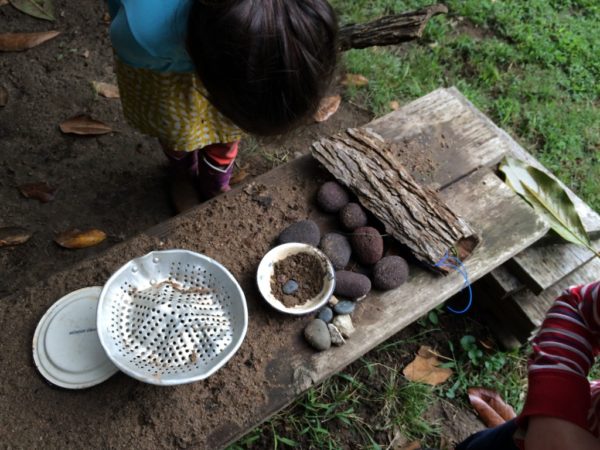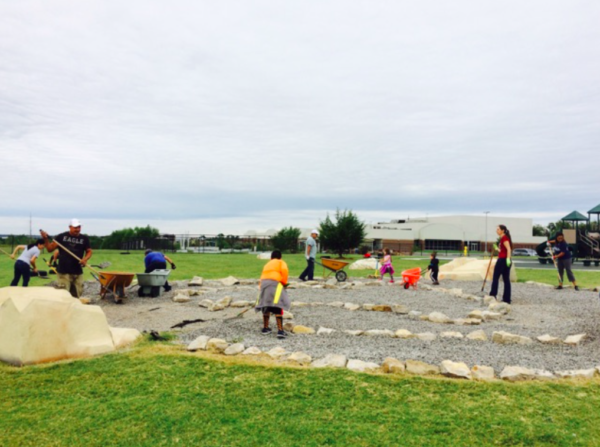If you should ask me – What do you remember about your childhood? – I would answer: playing outdoors. I remember, like yesterday, creating a little hide-out under a group of tall bushes. I would spend hours with my friends gathering twigs and rocks to make those bushes into a secret hide-out.
Children have a natural desire to play outside.
Think about it. The young child is a sensory being processing life through the senses. Playing outside nourishes the senses naturally.
I have the joy of volunteering at a Waldorf-inspired “forest” Kindergarten. We spend 90% of the day outside. Rain or shine. In the short time I have been here – I am convinced. This is what children need. I have watched and I see the benefits. Here are a few. . .
It improves academic achievement. The nurturing of the senses is the foundation of cognitive development. The outdoors provides a direct experience with ideas such lifecycle, weather, weight and more. Research has shown children who are given plenty of time outdoors score higher on standardized testing in math, reading and writing. It takes learning to a multi-sensory level – touch, smell, hearing, taste and sight. It is the ultimate laboratory for testing theories and ideas. At the “forest” kindergarten the sand pit becomes an experiment of heavy and light, wet and dry, in and out. Water is added to a bucket of sand. Immediately the chirping of sensory based observation arises. “Water makes the sand heavier.” “Dry sand will not clump!”
It improves creativity. The raw materials of nature ignite the creativity of children. Loose parts in the outdoor space provide endless opportunities for creativity, inventions, experiments, and resourcefulness. Studies have shown that children engage in more creative forms of play when outside. It is inquiry-based learning in a natural setting. But more than that – it offers up a blank canvas of natural materials – willing to become anything. This is the work of the frontal lobes. This is the future of higher order thinking. Creativity is the ticket. Nature is the doorway.
It increases Appreciation & Respect for Nature. Exposure to the natural world builds a sense of wonder for the beauty of life. Learning outside gives children the opportunity to witness the interdependence of animals, plants and humans. Studies have shown a 27% increase in science testing scores with plenty of time outside. Today a little girl at this forest school picked up a piece of bark for the making of a “fairy house.” Underneath were snails and spiders. Lots of them. She gingerly held the piece of bark and told me, “The fairies love snails and spiders.” These creatures were welcomed.
It improves health and Well-Being. Outdoor play helps to form a life long health disposition. Outdoor play encourages the development of active movement. For healthy reflex development children need spaces to move both up and down and to explore their own capacities to move. I am amazed at how much the children run and jump and play. A rich outdoor space provides endless potential for developing the complex neutral pathways built only in the rigor of healthy play.
It improves Behavior and Social Interactions. Ample time outside has proven to reduce challenging behaviors. Interestingly, the more children are given time outside the less challenging behaviors occur. Children are better able to cooperate and problem solve social conflicts. Additionally, time outside simply helps to reduce stress. It is no mistake the majority of “relaxing” videos on Youtube have included nature sounds. It is stunning to watch children negotiate and problem solve as the play unfold. Honestly, I have never seen such healthy social/emotional support as nature supplies. Just the other day – I watched as the children gathered around a little pond of fishes. The delight and wonder of life itself captivated the children.
It seems to be how it goes in the outdoors.
One of the things I am committed to doing as a business owner is contribute money towards innovative and progressive practices in early childhood education.
Recently, Fairy Dust Teaching funded a rock maze.










We run an outdoor pre school and outdoor after school and holiday club. If you ever need us for case study or similar or just want to visit, please let me know- more than happy to help. Thank you
Follow on FB – highway farm activity centre
Or
http://www.highwayfarm.com
Thank you for your time
Yes! I will email you! I would love to connect!
I have returned to a formal classroom after a 15 year hiatus spent as a homeschooling mother to my own 8 children. I love your ideas and I am slowly implementing many of them. I’ve started with birthday displays, a storytelling table, and loose parts investigations. I am looking forward to moving outside more and need practical ideas for an urban midwest setting.
Wow – what a rich background you bring to teaching. My own homeschooling is what began the journey of teaching. Keep me posted on your outdoor spaces!
Thankyou, I really enjoyed this post. The outdoors provide such an amazing learning space!
It is true magic!
So many of our preschoolers are placed in front of the TV to finish their dinner and hurry to the bath tub put on jammies and get to bed. Outside allows the opportunities to get that last bit of steam out. Outside morning group time is refreshing!!
Isn’t that the truth! And the children flourish outside. It’s so sad how many screens kids are exposed to at such an early age.
This reminds me of my childhood. I lived in a farm and all day long me and my brothers and sisters were outdoors.
What a gift! What rich memories!
This article make me want to print countless copies of it and stick in centres all around my area. Children need to be outside and just be.
Agreed! Last year my first graders had, at best, 20 minutes a day. It is not enough. And this is the norm.
Outside is so valuable. I have been in the Early Childhood field for years and wow how things can change. It take the right teacher with understanding that so much can happen outside. The kids are not scared to explore or dig in the dirt (we should not be either) and eagerly want to share the…..bug!!
Ha! Yes, And I agree Sheri, we should be role models even when handling the…bug! Such rich experiences and vocabulary can be enjoyed in the great outdoors.
I absolutely love the outdoor, children can feel freedom, exploration , wonder , it’s magical , a connection with nature ???????
I’m sorry those questions marks were suppose to be emojis, I guess they aren’t compatible with the board
Hi Sally, where is this school? Is it in Tulsa?
It is tucked away in a secret spot in Tulsa!
Love this information- with a strong movement towards Makerspaces, some people need to be reminded that sand boxes, water tables and other tactile and multi sensory outdoor experiences are appropriate Makerspaces for younger students. They don’t have to be super elaborate, pricy learning environments, as some districts are currently designing. Thanks for the info, I plan on sharing it with administrators and staff here in sunny CA!
Exactly! That is my exact feeling! In fact, I feel like the expensive, elaborate out learning spaces are not as engaging. Rich outdoor learning is so economical!!!!
How many hours?
3 hours!
This can help me on my project and grade
Love your blog Sally. SO so so inspiring. Have been following you for quite some time now. This post is particularly interesting as I am running a series on my blog describing how I slowly tried to create a more nature-filled outdoor environment for the children in my setting. Would it be OK for me to quote you ? You can check the first 2 posts at http://theguilletots.blogspot.ie/2016/05/creating-naturalistic-play-ares-part-1.html
Thanks Sally
Sure! No problem!
I am a retired Elementary teacher. I taught K and 2nd grade over 25 years. I had the great opportunity to visit the Early Childhood Schools of Reggio Emilia in 1991. I used the Approach in my Public School Kindergarten for seventeen years! Now I am a grandma and follow your posts…. Great job!!
Oh my goodness! That is amazing! Some day I would love to chat! I am starting a Podcast – would you be willing to be a guest? I think you have so much to share!! Big hugs!
Absolutely! My first daughter in law is studying to be a Middle School Science teacher. We have great conversations about the thrill of teaching through love of nature. She & our son have two children. Sam is four and Mabel is one. I already spend quite a lot of time using my Reggio influences as we play and learn together. My second son is engaged to a lovely young lady who will be an Early Childhood teacher upon her graduation in May 2017. I’ve shared your website with her, she loves it! Both girls are receiving their degrees from Webster University here in St. Louis, where I originally learned the Reggio Approach. In my retirement, I am working with my church’s small learning center. Congrats on getting the word out-it changed my world to use this outstanding approach with youngsters.